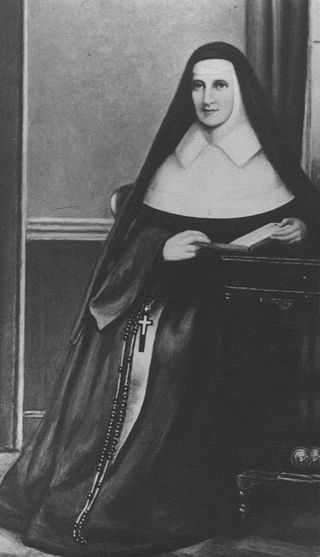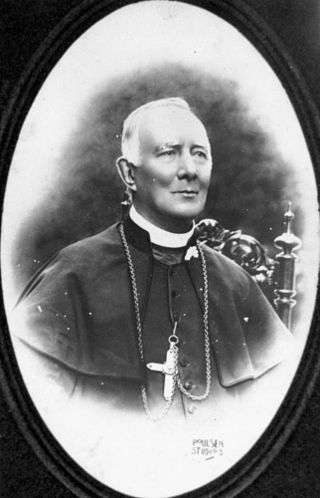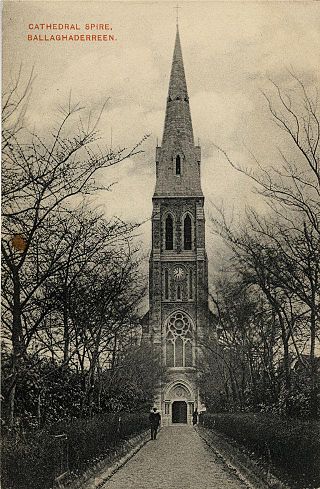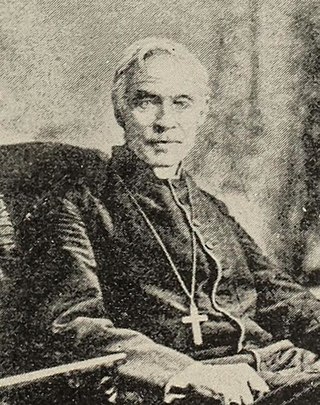Primate is a title or rank bestowed on some important archbishops in certain Christian churches. Depending on the particular tradition, it can denote either jurisdictional authority or (usually) ceremonial precedence.

The Sisters of Mercy is a religious institute for women in the Roman Catholic Church. It was founded in 1831 in Dublin, Ireland, by Catherine McAuley. As of 2019, the institute has about 6200 sisters worldwide, organized into a number of independent congregations. They also started many education and health care facilities around the world.

Patrick John Ryan was an Irish-born Catholic prelate who served as Archbishop of Philadelphia from 1884 until his death in 1911.

St Patrick's, Carlow College, is a liberal arts college located in Carlow, Ireland. The college is the second oldest third level institution in Ireland and was founded in 1782 by James Keefe, then Roman Catholic Bishop of Kildare and Leighlin, and his co-adjutor bishop Daniel Delany.

Mary Frances Xavier Warde R.S.M. (1810-1884) was one of the original Sisters of Mercy, a Roman Catholic religious congregation of women founded in Ireland by Catherine McAuley, and the foundress of the order in the United States.

John England was an Irish-born American prelate of the Catholic Church. He served as the first Bishop of Charleston, leading a diocese that then covered three Southern states. England previously served as a priest in Cork, Ireland, where he was active in the movement for Catholic emancipation in the British Isles. As bishop in Charleston, he ministered to and provided education for many free and enslaved African-Americans.
Saint Fiacc was a poet, the chief bishop of Leinster, and founder of two churches.

Patrick Francis Moran was a prelate of the Catholic Church and the third Archbishop of Sydney and the first cardinal appointed from Australia.

James O'Connor, S.J. was the first Catholic Bishop of the Diocese of Omaha, Nebraska.

John Dubois was a French-born Catholic prelate who served as Bishop of New York from 1826 until his death in 1842.

The Diocese of Ferns is a Latin Church diocese of the Catholic Church in south-eastern Ireland. It is one of three suffragan dioceses in the ecclesiastical province of Dublin and is subject to the Archdiocese of Dublin. The incumbent Ordinary is Gerard Nash.

The Diocese of Kildare and Leighlin is a Latin Church diocese of the Catholic Church in eastern Ireland. It is one of three suffragan dioceses in the ecclesiastical province of Dublin and is subject to the Archdiocese of Dublin. On 7 May 2013, Denis Nulty was appointed bishop of the diocese.

The Diocese of Achonry is a Latin Church diocese of the Catholic Church in the western part of Ireland. It is one of the five suffragan sees of the Archdiocese of Tuam. The diocese was often called the "bishopric of Luighne" in the Irish annals. It was not established at the Synod of Rathbreasail, but Máel Ruanaid Ua Ruadáin signed as "bishop of Luighne" at the Synod of Kells.

Daniel Delany DD was the Roman Catholic Bishop of Kildare and Leighlin. Educated at the Irish College in Paris, he taught at the English Boys College of St Omer, 265 kilometres north of Paris.
Events from the year 1747 in Ireland.

Delany College is an independent Roman Catholic comprehensive co-educational secondary day school, located in Granville, a western suburb of Sydney, New South Wales, Australia; in the tradition of the Patrician Brothers. Founded in 1942 as the Patrician Brothers' High School, the College is administratively overseen by the Catholic Education Office of the Diocese of Parramatta.

The Brigidine Sisters are a global Roman Catholic congregation, founded by Bishop Daniel Delany in Tullow, Ireland on 1 February 1807. The sisters' apostolate is education.

Andrew J. Byrne was an Irish-born American Catholic priest, who became the first bishop of the Diocese of Little Rock in Arkansas from 1844 until his death in 1862.

Eugene O'Connell was the first Catholic bishop of the Catholic Diocese of Grass Valley, California. Born in County Cavan, Ireland, O'Connell sailed to San Francisco upon the request of Bishop Alemany for priests to serve in the diocese of Monterey. O'Connell was rector of the diocesan seminary, and later appointed to the Vicariate of Marysville, up in the gold fields. The Diocese of Grass Valley later became the Diocese of Sacramento.

The Cathedral of the Assumption is both the cathedral church of the Roman Catholic Diocese of Kildare and Leighlin and the parish church for the cathedral parish. Located in Carlow town, the cathedral was dedicated to the Assumption of the Blessed Virgin Mary in 1833. It is known for its beautifully detailed 151 ft (46 m) spire which is one of the highest points in the town.


















